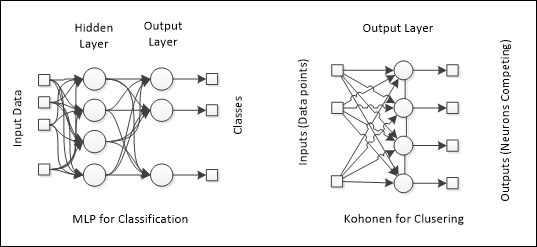For pattern recognition, the neural network architectures that can be applied are the MLPs (supervised) and the Kohonen network (unsupervised). In the first case, the problem should be set up as a classification problem, that is, the data should be transformed into the X-Y dataset, where for every data record in X, there should be a corresponding class in Y. As stated in Chapter 3, Handling Perceptrons, and Chapter 6, Classifying Disease Diagnosis, the output of the neural network for classification problems should have all of the possible classes, and this may require preprocessing of the output records.
For the other case, the unsupervised learning, there is no need to apply labels on the output; however, the input data should be properly structured as well. To remind the reader, the schemas of both neural networks are shown in the following figure:

In pattern recognition, we have to deal with all possible types of data, as well as in clustering:
- Numerical
- Continuous or real
- Discrete
- Categorical
- Ordinal
- Unscaled
However, here, we have the possibility to perform pattern recognition on multimedia content, such as images and videos. So, how should multimedia be handled? The answer to this question lies in the way these contents are stored in files. Images, for example, are written with a representation of small colored points called pixels. Each color can be coded in an RGB notation where the intensity of red, green, and blue defines every color that the human eye is able to see. Therefore, an image of dimensions 100 × 100 would have 10,000 pixels, each one having three values for red, green, and blue, yielding a total of 30,000 points. This is a challenge for image processing in neural networks.
Some methods, which will be reviewed in the next chapter, may reduce this huge number of dimensions. Then, an image can be treated as a big matrix of numerical continuous values.
For simplicity, in this chapter, we discuss only grayscale images with small dimensions.
